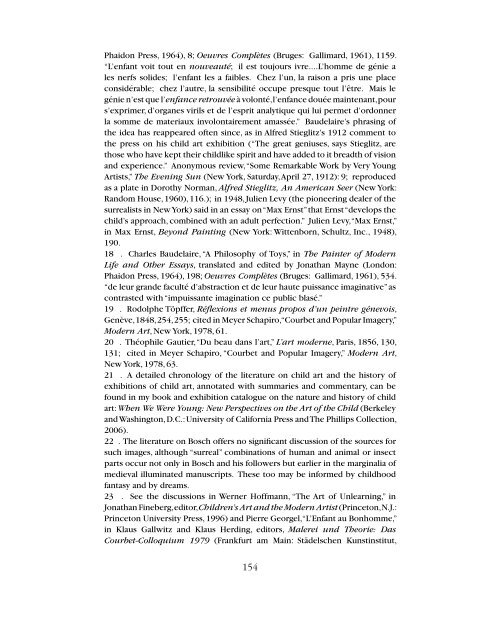Jonathan Fineberg – The Postman Did It – Children’s Art and the Avant-garde
Excerpt from “A Kid Could Do That!”, an extensive publication prepared by Galerie Gmurzynska on the occasion of the large-scale eponymous exhibition project at Art Basel Miami Beach 2014, conceived with Hollywood luminaries Baz Luhrmann and Catherine Martin.
Excerpt from “A Kid Could Do That!”, an extensive publication prepared by Galerie Gmurzynska on the occasion of the large-scale eponymous exhibition project at Art Basel Miami Beach 2014, conceived with Hollywood luminaries Baz Luhrmann and Catherine Martin.
- No tags were found...
You also want an ePaper? Increase the reach of your titles
YUMPU automatically turns print PDFs into web optimized ePapers that Google loves.
Phaidon Press, 1964), 8; Oeuvres Complètes (Bruges: Gallimard, 1961), 1159.<br />
“L’enfant voit tout en nouveauté; il est toujours ivre....L’homme de génie a<br />
les nerfs solides; l’enfant les a faibles. Chez l’un, la raison a pris une place<br />
considérable; chez l’autre, la sensibilité occupe presque tout l’être. Mais le<br />
génie n’est que l’enfance retrouvée à volonté, l’enfance douée maintenant, pour<br />
s’exprimer, d’organes virils et de l’esprit analytique qui lui permet d’ordonner<br />
la somme de materiaux involontairement amassée.” Baudelaire’s phrasing of<br />
<strong>the</strong> idea has reappeared often since, as in Alfred Stieglitz’s 1912 comment to<br />
<strong>the</strong> press on his child art exhibition (“The great geniuses, says Stieglitz, are<br />
those who have kept <strong>the</strong>ir childlike spirit <strong>and</strong> have added to it breadth of vision<br />
<strong>and</strong> experience.” Anonymous review, “Some Remarkable Work by Very Young<br />
<strong>Art</strong>ists,” The Evening Sun (New York, Saturday, April 27, 1912): 9; reproduced<br />
as a plate in Dorothy Norman, Alfred Stieglitz, An American Seer (New York:<br />
R<strong>and</strong>om House, 1960), 116.); in 1948, Julien Levy (<strong>the</strong> pioneering dealer of <strong>the</strong><br />
surrealists in New York) said in an essay on “Max Ernst” that Ernst “develops <strong>the</strong><br />
child’s approach, combined with an adult perfection.” Julien Levy, “Max Ernst,”<br />
in Max Ernst, Beyond Painting (New York: Wittenborn, Schultz, Inc., 1948),<br />
190.<br />
18 . Charles Baudelaire, “A Philosophy of Toys,” in The Painter of Modern<br />
Life <strong>and</strong> O<strong>the</strong>r Essays, translated <strong>and</strong> edited by <strong>Jonathan</strong> Mayne (London:<br />
Phaidon Press, 1964), 198; Oeuvres Complètes (Bruges: Gallimard, 1961), 534.<br />
“de leur gr<strong>and</strong>e faculté d’abstraction et de leur haute puissance imaginative” as<br />
contrasted with “impuissante imagination ce public blasé.”<br />
19 . Rodolphe Töpffer, Réflexions et menus propos d’un peintre génevois,<br />
Genève, 1848, 254, 255; cited in Meyer Schapiro, “Courbet <strong>and</strong> Popular Imagery,”<br />
Modern <strong>Art</strong>, New York, 1978, 61.<br />
20 . Théophile Gautier, “Du beau dans l’art,” L’art moderne, Paris, 1856, 130,<br />
131; cited in Meyer Schapiro, “Courbet <strong>and</strong> Popular Imagery,” Modern <strong>Art</strong>,<br />
New York, 1978, 63.<br />
21 . A detailed chronology of <strong>the</strong> literature on child art <strong>and</strong> <strong>the</strong> history of<br />
exhibitions of child art, annotated with summaries <strong>and</strong> commentary, can be<br />
found in my book <strong>and</strong> exhibition catalogue on <strong>the</strong> nature <strong>and</strong> history of child<br />
art: When We Were Young: New Perspectives on <strong>the</strong> <strong>Art</strong> of <strong>the</strong> Child (Berkeley<br />
<strong>and</strong> Washington, D.C.: University of California Press <strong>and</strong> The Phillips Collection,<br />
2006).<br />
22 . The literature on Bosch offers no significant discussion of <strong>the</strong> sources for<br />
such images, although “surreal” combinations of human <strong>and</strong> animal or insect<br />
parts occur not only in Bosch <strong>and</strong> his followers but earlier in <strong>the</strong> marginalia of<br />
medieval illuminated manuscripts. These too may be informed by childhood<br />
fantasy <strong>and</strong> by dreams.<br />
23 . See <strong>the</strong> discussions in Werner Hoffmann, “The <strong>Art</strong> of Unlearning,” in<br />
<strong>Jonathan</strong> <strong>Fineberg</strong>, editor, <strong>Children’s</strong> <strong>Art</strong> <strong>and</strong> <strong>the</strong> Modern <strong>Art</strong>ist (Princeton, N.J.:<br />
Princeton University Press, 1996) <strong>and</strong> Pierre Georgel, “L’Enfant au Bonhomme,”<br />
in Klaus Gallwitz <strong>and</strong> Klaus Herding, editors, Malerei und Theorie: Das<br />
Courbet-Colloquium 1979 (Frankfurt am Main: Städelschen Kunstinstitut,<br />
154

















